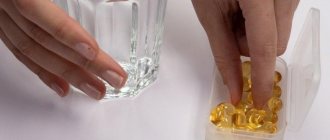Vitamin D successfully participates in thirty biochemical reactions that occur during human metabolism. Its presence is necessary in sufficient quantities throughout the entire calendar year, so a person who wants to stay healthy no longer has to wonder why vitamin D3 is needed.
There are two most useful forms:
- D2 (ergocalciferol), which enters the body with food (fatty fish, animal liver and kidneys, egg yolks, dairy products, butter, hard cheeses);
- D3 (cholecalciferol). It comes from food and is also synthesized in the body independently.
The importance of vitamin D plays an important role starting from birth, or rather, from the moment a person is conceived. The direct participation of the element in the metabolism of calcium and phosphorus, which, like “bricks”, build the child’s bone skeleton, is extremely important during the period of growth and formation. This is a real “protector” that prevents the risk of developing rickets in premature and weak newborn babies.
By taking vitamin D3, a child is almost 100% able to meet the need for the microelement in the body. This is especially important in the absence of breastfeeding (before complementary feeding). With the help of vitamin D, metabolic processes in cartilage, joint and bone tissues are supported throughout the entire period of life, and losses during menopause and with the onset of old age are compensated. The need for vitamin D is vital for both children and adults, pregnant and lactating women. This rule especially applies to regions with reduced solar activity and a small number of clear days.
The mechanism of formation of vitamin D3 is closely related to the absorption and production of ultraviolet radiation by human skin and exposure to air in open clothing.
Important! Exposure of an adult to the sun for about 6 hours in open clothing provides a daily dose of vitamin D of 10 mcg.
Risk factors for the development of vitamin deficiency
Let's look at the main reasons why vitamin deficiency may occur:
- Vegetarianism, dieting.
- Limited exposure to sunlight.
- Dark skin color.
- Limited sleep, night shifts.
- Living in environmentally unsafe areas.
- Chronic gastrointestinal diseases.
If we take into account possible dietary errors and infrequent exposure to the sun, it becomes clear that there is a risk of vitamin D deficiency in a large percentage of people (both children and adults).
Release form
There are several main forms of vitamin D3: tablets and capsules, softgel capsules filled with fish oil or oil (most often soybean), chewable candies or lozenges, and solution.
Tablets and gelatin capsules are the most common format for any vitamins, but they are absorbed more slowly, and if we talk about tablet forms, they can lose some of the active substances while they go through all stages of complex digestive processes.
The advantage of softgel capsules is that fat-soluble vitamin D is placed in an oil environment, making it better absorbed in the body. In addition, softgel capsules are easier to swallow.
Vitamin D3 in liquid form, as well as in the form of lozenges and candies, is best absorbed. The solution can be diluted in water or in a non-hot drink, and chewing candies are suitable for those who have difficulty swallowing regular capsules or tablets, and it should be noted that there is a pleasant bonus in the form of fruit or berry flavors.
Indications for use
Let's consider the main conditions in which it is necessary to replenish vitamin D3 for preventive or therapeutic purposes.
In children:
- Disturbances in the growth and development of bones and joints, skeleton.
- Risk of rickets.
- Signs of vitamin deficiency.
Important! Before taking it, it is recommended to take a blood test to confirm the level of the substance. Based on the results of the examination, the doctor will make an individual prescription, taking into account the patient’s age, indications, place of residence, type of activity, concomitant pathologies, etc.
In adults:
- Presence of signs of vitamin D deficiency.
- Pregnancy and breastfeeding (to prevent pathologies of fetal development).
- Complaints of muscle cramps, spasms.
- Osteoporosis, joint damage, bone fractures.
- Calcium and phosphorus deficiency, poor absorption.
- Bone marrow diseases.
- Complex treatment of cardiovascular system, gastrointestinal tract.
- Enterocolitis.
- Comprehensive treatment of systemic lupus erythematosus, skin tuberculosis, type 2 diabetes, psoriasis.
- Prevention of occupational diseases (in metallurgy).
- Hypoparathyroidism.
- Prescription of glucocorticosteroids.
- Decreased immunity, frequent seasonal diseases.
Important! The use of vitamin D without tests and doctor's prescription is possible only for preventive purposes.
How to take vitamin D?
The role of vitamin D in the human body is enormous. In addition to regulating the metabolism of calcium and phosphorus, this hormone-like substance in its structure takes part in the work of all parts of the immune system, preventing not only infectious but also oncological pathologies. Calciferol also has a beneficial effect on the functioning of the cardiovascular system, takes part in the regulation of carbohydrate and hormone metabolism, and even helps prevent depression! To date, the participation of vitamin D in more than thirty different physiological processes is reliably known, and, according to scientists, this is not the limit. Many beneficial properties of calciferol have not yet been studied and, perhaps, we will soon learn about new roles for this vitamin. But there is also something that scientists and doctors know for sure: every second inhabitant of our planet is deficient in vitamin D. And one of the most reliable sources of this substance is calciferol supplements. How to take vitamin D correctly? Are there any nuances to taking such supplements for children and adults? Does the reception depend on the time of year? Let's find out!
Who should take vitamin D supplements?
There is still a strong stereotype in society according to which calciferol does not need to be taken (or only infants need to take it) - they say that it is still produced in the skin under the influence of sunlight and there is a lot of it in food. In fact, everything is far from so rosy: indeed, sunlight contributes to the body’s production of its own vitamin D, but in order for this amount to be sufficient all year round, you need to live south of the 40th parallel (in the southern hemisphere - north).
The entire territory of Russia lies in a zone of insufficient insolation, so residents of the southern regions of the country need additional vitamin D intake in the autumn-winter period, and those living in the northern regions need it year-round.
Food is also not a reliable source of calciferol: only some foods are rich in it: red fish, cod liver, fatty herring, which are not the basis of the daily diet. There is quite a lot of vitamin D in the yolk of eggs and hard cheese, but to meet the body’s needs, such products must be consumed in large quantities, which will put a strain on the liver and can cause excess weight. Therefore, almost every person is recommended to take preventive or therapeutic doses of vitamin D.
Babies and children
The main indication for taking vitamin D in childhood is its deficiency in the blood, which causes:
- rickets - deformation of bone tissue due to disturbances in calcium and phosphorus metabolism;
- spasmophilia (convulsions) associated with low levels of calcium in the blood;
- weakening of the immune system.
For adults
In adulthood, taking vitamin D is also indicated for its deficiency, which can manifest itself:
- osteoporosis - excessive fragility of bones due to impaired calcium and phosphorus metabolism;
- osteomalacia - softening of bone tissue due to a deficiency of minerals in it;
- osteochondrosis, osteoarthrosis - increased mineralization of joint tissue due to calcium metabolism disorders;
- long healing of fractures;
- tooth decay;
- weakening of the immune system, which can cause both frequent infectious diseases and the development
- oncopathology;
- autoimmune diseases;
- hypertension;
- hypofunction of the thyroid gland;
- diseases associated with disruptions in carbohydrate metabolism (obesity, diabetes).
In addition, additional intake of calciferol preparations (or taking higher doses as prescribed by a doctor) is recommended for those who, for one reason or another, have impaired absorption of vitamin D: people with diseases of the digestive tract, liver and kidneys. Additional doses may also be indicated for those with excess body weight, since the consumption of calciferol during physiological processes is higher in such people.
Who should not take vitamin D?
In addition to the list of indications, there is also a list of contraindications for taking calciferol supplements. In this case, we are only talking about additional intake of multivitamin preparations; significant diet correction or restriction of sun exposure is not required in such cases.
List of contraindications for taking calciferol:
- hypervitaminosis (excessive level in the body) of vitamin D;
- excess calcium in the blood;
- acute renal and liver failure;
- individual intolerance to vitamin D preparations;
- sarcoidosis or pulmonary tuberculosis in the active phase.
Vitamin D should be administered with caution to some patients:
- those suffering from urolithiasis;
- infants in the first month of life (strictly according to indications);
- pregnant and lactating women (as prescribed by a doctor and under his supervision);
- if necessary, simultaneous use with certain drugs (diuretics, cardiac glycosides - they must be taken separately from calciferol, with a time interval of at least 2 hours).
Which form of vitamin D is most effective?
Today, there are many different preparations with vitamin D: aqueous solutions in the form of drops, oil solutions in drops and capsules, solutions in ampoules for intramuscular administration, dragees, capsules and even chewable tablets. Moreover, there is still a popular opinion that since vitamin D is fat-soluble, its only effective form is an oil solution. In fact, an aqueous solution is absorbed even faster; the absorption of an oil solution of vitamin D requires normal functioning of the enzyme systems of the gastrointestinal tract.
At the same time, both aqueous and oil solutions of vitamin D have their drawbacks: solutions in drops are simply inconvenient to take, especially for people leading an active lifestyle. The dosage in drops is extremely inconvenient, and violations of administration are possible. In addition, many people do not like the taste of the oil solution. Taking an oil solution of vitamin D in capsules eliminates the taste problem, but the gelatin shell of the capsules does not dissolve well in all people. Therefore, chewable tablets are considered one of the most convenient forms of vitamin D for adults today. You can read more about this form here.
Briefly about the different forms of vitamin D:
- chewable tablets , capsules, dragees - suitable for adults; an aqueous solution in drops is the only dosage form suitable for infants; adults can also take it;
- the oil solution in drops can be taken by both children and adults;
- oil solution for injection is used to correct severe hypovitaminosis, as well as in persons with impaired intestinal absorption function.
How to take vitamin D for children?
For children in the first year of life, the optimal dosage form is an aqueous solution of vitamin D: it is convenient and safe to give to the baby, and it is well absorbed even in the presence of intestinal dysbiosis, which is natural for the baby in the first months of life. In addition, an aqueous solution of calciferol can be taken at any time of the day, regardless of meal times.
Vitamin D oil solution is better absorbed if taken at the same time as food. This form of the drug is more suitable for children of preschool and primary school age. Schoolchildren can take calciferol in any form: capsules, dragees, children especially like chewable tablets, the absorption of vitamin D from which begins in the oral cavity. Chewable tablets are not indicated for children.
How to take vitamin D for adults?
Any form of vitamin D is suitable for adults, so you can choose the best option for yourself based on your preferences, body characteristics, age, goals, and lifestyle nuances. Like all vitamins, calciferol should be taken in the first half of the day.
In old age
Taking calciferol by older and elderly people is very important: over the years, the intensity of vitamin D synthesis in the skin gradually decreases, at the same time a physiological change in hormonal levels and calcium balance in the body occurs. The fragility of bones increases, the frequency of fractures increases, which are subsequently extremely difficult to heal. Taking vitamin D helps harmonize phosphorus-calcium metabolism. The following forms have worked well:
- water-based drops - are well absorbed in the intestine even with a decrease in its functional activity, which is not uncommon in old age;
- oil-based preparations (drops, capsules) are absorbed worse than water-based ones, but are less likely to cause an overdose associated with additional intake of calciferol by mistake or due to forgetfulness.
The best solution for an elderly person would be to take vitamin D over a long period of time in a small dosage. In this case, the form of chewable tablets is especially convenient, the use of which minimizes the risk of dosing violations due to difficulties with counting drops or spilling of the solution when using liquid forms.
Taking calcium supplements in addition to vitamin D in older people should take into account the age-related characteristics of phosphorus-calcium metabolism. It is recommended to first determine your blood calcium level and then decide whether to take additional supplements.
During pregnancy
The body of the expectant mother is the only source of vitamin D for the fetus; accordingly, calciferol consumption increases during pregnancy. It is known that with vitamin D deficiency, the risk of pregnancy complications (preeclampsia, preeclampsia and eclampsia) increases, and premature birth occurs more often. Therefore, it is important during routine monitoring of pregnancy to be sure to monitor the level of calciferol in the blood and, if necessary, correct its deficiency; if there is no deficiency, take vitamin D in a preventive dosage, having agreed upon it with the doctor monitoring the pregnancy.
To reduce body weight
It is known that vitamin D takes part in carbohydrate metabolism - accordingly, its sufficient level is necessary to maintain normal body weight. Therefore, doctors are increasingly making recommendations about the importance of providing the body with calciferol for the successful treatment of obesity. But when trying to get vitamin D from food, a contradiction arises: this substance is found mainly in high-calorie, high-fat foods. It is practically impossible to achieve a caloric deficit in the diet and at the same time meet the need for calciferol only from food. Therefore, taking vitamin D supplements is especially important for overweight people.
In this case, the dosage can be significantly higher than for a person with normal body weight, since the consumption of calciferol in the presence of extra pounds is greater. The best solution would be to work with your dietitian or therapist to calculate the optimal dosage of vitamin D based on the results of a blood test.
For psoriasis
Psoriasis is an autoimmune pathology, and taking vitamin D supplements can significantly improve its course. In addition to supplements, the use of calciferol creams is recommended. The specific drug, its dosage, frequency of use and duration of the treatment course will be advised by a dermatologist.
Vitamin D supplementation should be based on its compatibility with other vitamins and minerals.
Should you take vitamin D in summer?
As a rule, preventive intake of vitamin D is recommended in the autumn-winter period - when solar radiation is insufficient and the body is covered with clothing. During the summer, it is important to spend at least 20 minutes a day in the morning or evening sun, with your arms and legs exposed, without using sunscreen. Holidays at resorts are also useful: calciferol, actively produced in the skin during this period, accumulates in the body and serves as a reserve for the future.
However, in most regions of Russia, including the southern ones, people with a high risk of vitamin D deficiency (rarely exposed to the sun, patients with obesity, dark skin, impaired absorption in the intestines, etc.) are recommended to take vitamin D supplements year-round. including in the summer. In order to accurately determine whether you need calciferol or not, it is recommended to test the level of the transport form of vitamin D 25(OH)D in the blood and consult with a doctor who will recommend the optimal dosage of calciferol and the duration of its use.
Overdose of the drug
Let's consider the possible risks of excessive use of dietary supplements:
- Indigestion, nausea, vomiting, upset stomach.
- Headaches, dizziness.
- Convulsions, breathing problems.
- Loss of appetite.
- Changes in mood, nervousness.
- Rashes on the body.
- Loss of consciousness.
It should be noted that taking the drug is cumulative. The body creates a kind of reserve, which it spends when you stop using dietary supplements or as needed. If the dosage is followed correctly and the period is not exceeded, then, as a rule, no side effects are observed.
Why is vitamin D deficiency so widespread?
Firstly, the geographical location of our country. In most of Russia, from late autumn to early spring, virtually no vitamin D is synthesized in the skin, since during this period the level of solar insolation is reduced. Also, polluted air and dust interfere with the formation of vitamin D. Secondly, a connection has been established between early aging and the development of malignant skin tumors with exposure to UV rays. In this regard, it is recommended to spend less time in direct sunlight and use sunscreen. This, in turn, prevents the natural formation of vitamin D in the skin and leads to its deficiency in the body. Vitamin D deficiency is also common in dark-skinned people, since the pigment melanin is a factor that protects the skin from UV rays and interferes with the production of the vitamin.
Unfortunately, most people's diet does not include foods with sufficient vitamin D content. There are people who do not like fish at all or prefer less fatty varieties, while the highest content of the vitamin is in fatty fish. Also, vitamin D deficiency may be associated with impaired absorption in the digestive tract. People who are overweight also have a deficiency, since the vitamin accumulates in subcutaneous fat and does not enter the general bloodstream or other organs.
Contraindications for use
Let's consider the factors under which you should not additionally drink drugs containing ergocalciferol or cholecalciferol:
- individual intolerance, allergic manifestations;
- excess calcium and phosphorus;
- chronic diseases of the cardiovascular system, gastrointestinal tract in acute form;
- pulmonary tuberculosis;
- uncontrolled use;
- violation of metabolic processes;
- decreased immunity.
You cannot combine the use of vitamin D with calcium single preparations containing this substance, as well as with medications containing phosphorus in any form. Proper use in compliance with the dosage gives a lasting result.
Sources of Vitamin D3
Vitamin D3 is produced in one form - in the form of cholecalciferol, the difference between different supplements lies in the sources from which this cholecalciferol is obtained: fish oil, lanolin, mushrooms and lichens.
Information for vegetarians! Most vitamin D3 supplements are of animal origin, so vitamin D2 (ergocalciferol) supplements may be an alternative.
Lanolin is a wax that is isolated from sheep's wool and undergoes special processing to obtain cholecalciferol. It is lanolin that is most often used as a source of D3; it is well absorbed and does not cause allergic reactions.
Fish oil is also a popular raw material for supplements in liquid or softgel capsule form. Here you need to take into account that the liver of fish, which is more often used as a source, can accumulate mercury and toxins, and the product itself can be “heavy” for the stomach.
Cholecalciferol, obtained from lichens and fungi, is highly digestible and suitable for vegans and vegetarians, but this supplement is very expensive. When calculated per serving: one capsule costs from 20 rubles, for non-vegan products - from 5 to 15 rubles.
What foods contain vitamin D?
| Food | Amount of vitamin D (D2 and D3) in IU |
| Wild salmon | 600-1000 IU per 100 g |
| Farm raised salmon | 100-250 IU per 100 g |
| Herring | 294-1676 IU per 100 g |
| Som | 500 IU per 100 g |
| Canned sardines | 300-600 IU per 100 g |
| Canned mackerel | 250 IU per 100 g |
| Canned tuna | 236 IU per 100 g |
| Fish fat | 400-1000 IU per 1 tbsp. spoon |
| UV irradiated mushrooms | 446 IU per 100 g |
| Mushrooms not irradiated with UV | 10-100 IU per 100 g |
| Butter | 52 IU per 100 g |
| Milk | 2 IU per 100 g |
| Milk fortified with vitamin D | 80-100 IU per glass |
| Sour cream | 50 IU per 100 g |
| Egg yolk | 20 IU per 1 piece |
| Cheese | 44 IU per 100 g |
| Beef liver | 45-15 IU per 100 g |
The inactive form of vitamin D enters the body with food and is formed in the skin under the influence of UV rays. Then the liver undergoes a process of hydroxylation and conversion of the inactive form of the vitamin into 25(OH)D (calcidiol). Next, active vitamin D is formed in the kidneys - 1.25 (OH)2D (calcitriol). Vitamin D content is usually assessed by the concentration of calcidiol 25(OH)D in the blood. It is a more indicative marker, since its half-life is 2-3 weeks.
How to take vitamin D for adults
Standard dosages were developed by the Russian Ministry of Health and are included in clinical recommendations:
- up to 50 years - 600–800 IU;
- after 50 years - 800–1000 IU;
- pregnant and lactating women - 800–1200 IU.
These are preventive dosages that an adult can take without any health risk. You should not increase them at your own discretion: the substance accumulates in the body, and its excess can provoke acute poisoning. If you overeat it over a long period of time, it can cause kidney damage and impaired bone density.
A dosage of 4000 IU per day is considered toxic. However, this does not apply to people whose intestinal absorption of vitamin D is reduced due to diseases of the digestive system. For such patients, the doctor may recommend larger dosages: 6000, 10,000 IU. You can take drugs in this dosage only as prescribed and under the supervision of a doctor. In case of severe deficiencies, they are prescribed in a course of one to two months, until sufficient concentration “accumulates” in the body. Then, as a rule, they move on to a maintenance dosage that does not exceed the norm.
According to endocrinologist Marina Sviridonova , take the drug with meals. The nutrient is well absorbed with fatty foods, as it is a fat-soluble vitamin.
pixabay.com/
What to eat?
Most cholecalciferol is found in fat from the liver and meat of fish: salmon, tuna and mackerel. According to scientists, two to three fish dishes per week can meet the need for this vitamin. You can get vitamin D from butter, dairy products and egg yolks. A less active form of this vitamin, D2, is found in plant products, such as parsley and nettle, as well as in mushrooms.







